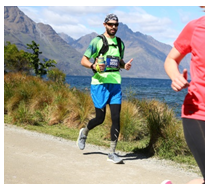Have you ever been exercising and felt the burn and inability to get enough air into your lungs..? We all have 🙂 ! Unlike the picture below, this is generally a sign of cardiovascular fitness and that the task was demanding more of our heart and lungs than we could deliver. Historically it was believed that a person’s breathing pattern was not a limiting factor in athletes due to the apparent breathing reserve (1). Whilst there is limited research into altered breathing mechanics and its effect on performance (2), more recent research suggest that this may not be the case and that working on breathing pattern and sporting performance could be of benefit.
Most of us take no notice of our breathing, which I must add is NORMAL! And the majority of us have a normal breathing pattern at rest and during exercise. However some of us may have an ineffective pattern when we exercise which leads to an overall reduced performance. So what is the cause and effect of an ineffective breathing pattern?
Cause (2)
- Pathological factors – for example exercise induced asthma
- Emotional factors – anxiety and stress (we all have it to some extend when we compete)
- Biomechanical factors – posture during chosen sport

- Physiological factors – changes to your breathing rate beyond the normal respiratory response to exercise and poor breathing mechanics at rest
Effect – all negative to performance
- Increasing breathing rate at the expense of maintaining your volume of air per breath (3)
- Continually breathing at higher (than normal) lung volume during performance (4,5)
- Increased work of breathing – muscles that control breathing fatigue earlier (6-8)
- Blood stealing – sounds horrible but put simply it is blood getting transferred away from your working muscle (i.e. leg muscles during running or cycling) and diverted to your breathing muscle as they are fatiguing (9)
So what can be done?
Breathing Pattern Retraining
This is a technique used by Physiotherapists to correct breathing pattern disorders and poor abnormal respiratory mechanics (10-12) and may benefit athletes by correcting resting breathing pattern disorders or poor mechanics. Correcting poor mechanics that arise from exercise and altering respiratory centres sensitivity to the build-up of the by-products of exercise (13,14).
I hope this helps you realise that getting breathless with exercise is normal and is generally a sign of fitness, and as you increase your training load then your fitness should also improve. However, if you are training hard and wanting to maximise your performance, then looking at your breathing pattern during your chosen sport may be the edge you require 🙂 .
Until next time,
Joel
Physiotherapist & Exercise Scientist
Certified Professional with “The Running Clinic”

